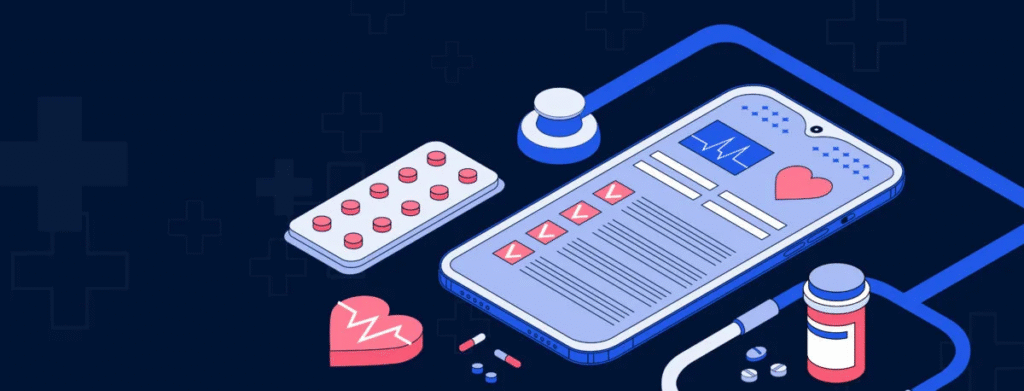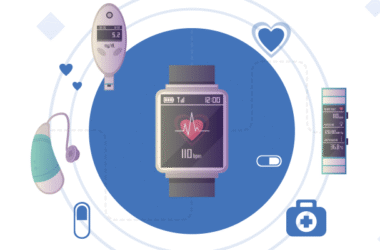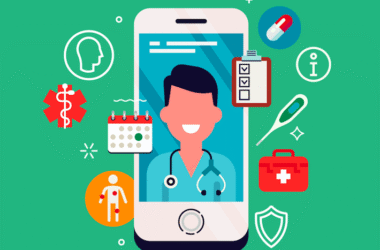Digital therapeutics use software programs to help people with long-term health issues like diabetes, heart disease, and high blood pressure. They work on phones, tablets, or computers to guide patients through care steps, track health signs, and share data with doctors. And they can send reminders to take medicines, suggest small habit changes, or connect users with health coaches. As a result, these tools can improve daily care, lower risks, and cut costs.
What Are Digital Therapeutics?
Digital therapeutics, often shortened to DTx, are software-based treatments. They are designed to help patients manage diseases by using proven methods that follow medical standards. These tools are more than just health apps. They must meet rules set by health agencies, and in many cases, they need approval from regulators like the FDA. Some can even be prescribed by doctors just like medicine.
When a patient gets started, they usually download an app or log into a secure website. The software guides them through tasks, teaches important lessons, tracks their progress, and sends updates to their healthcare team. In some cases, doctors can see the results right away and make quick changes to the care plan. These tools are especially useful for people who need to stick to long-term routines or manage symptoms every day.
Why Digital Therapeutics Matter
Many people with chronic health issues find it hard to stick to treatments. Life gets busy. People forget to take pills or skip exercise. Digital therapeutics help solve this by breaking care into small, easy steps.
For example, someone managing high blood pressure may get daily reminders to check their blood pressure, record meals, or move more. And they get real-time feedback, like a message saying “Your blood pressure is lower today, great job staying active.
How DTx Improves Patient Engagement
One of the strongest benefits of digital therapeutics is how they improve patient involvement. When people understand what they need to do and why it matters, they tend to stay more committed. Digital tools offer visual charts, progress bars, and even small rewards to keep people engaged. A diabetes app might show how food choices affect blood sugar levels, and how walking after meals helps keep levels steady.
These small daily updates help patients see how their choices make a real difference. Unlike paper logs or one-time doctor visits, digital therapeutics keep people connected to their care all the time. And that makes it easier to stay on track.
Big Drops in Hospital Readmissions

Digital therapeutics also help people avoid hospital stays. Studies show big reductions in readmissions for those who use DTx tools. In a heart failure program that used remote digital tools, patients saw a 78% drop in hospital readmissions over 45 days. In another study focused on type 2 diabetes, digital therapeutic users had 36% fewer hospital returns in the first month after diagnosis.
Other broader studies have found that digital therapeutics can reduce hospital readmissions by 40 to 50 percent for many chronic conditions. That is good news for patients and hospitals. Fewer readmissions mean lower medical bills, fewer lost workdays, and less stress on caregivers. It also gives hospitals more space for urgent cases.
A Growing Market With Strong Support
The digital therapeutics market is growing fast, and it is not slowing down anytime soon. In 2024, the global DTx market was valued at around USD 7.67 billion. Experts expect it to grow to USD 32.5 billion by 2030, which is a yearly growth rate of nearly 28 percent.
At the same time, the wider chronic disease management market stood at about USD 6.2 billion in 2024 and may reach USD 18.8 billion by 2034, growing at nearly 12 percent each year. These strong numbers show that doctors, hospitals, and insurance companies see real value in these tools.
Governments are also watching closely. Some are starting to build digital therapeutics into national health systems. For example, Germany now covers certain digital tools under its public insurance system. This kind of support could make DTx programs more available to people in other countries, too.
Who Benefits Most From These Tools?
Digital therapeutics are helpful for many types of chronic diseases, but some patients benefit more than others. People with conditions that need daily tracking—like diabetes, heart disease, or chronic lung problems—get the most value. They can log daily symptoms, check vital signs, and follow action plans more closely.
Mental health is another area where digital tools are making a big difference. Many DTx programs now offer therapy sessions, breathing exercises, or mood tracking tools. These support services help people with anxiety, depression, or sleep issues manage symptoms without needing to visit a clinic in person.
Older adults who live alone may also benefit. Digital tools give them extra support and help alert their doctors if something changes suddenly. And for busy working adults, these tools fit into daily life without extra clinic visits or travel time.
Problems Still Need Solving
Even though digital therapeutics are helpful, they still face some problems. Some patients do not have strong internet at home. Others may not own smartphones or tablets. That makes it harder to use digital tools every day. Health systems must find ways to offer equal access so that people in rural or low-income areas do not get left out.
There are also trust issues. Some doctors still want more long-term proof that DTx works better than older care methods. Insurance companies also want more data before they agree to pay for these tools. Clinical trials and patient studies are helping, but it takes time to build full trust.
Another issue is data privacy. These tools collect personal health information, and they must keep it safe. Companies need strong systems to protect data from leaks or hacking. They also need to follow privacy laws in each country, which can be hard when users live in different regions.
Final Thoughts
Digital therapeutics are bringing big changes to the way chronic diseases are treated. By turning treatment plans into easy digital steps, these tools help people take better care of themselves, reduce trips to the hospital, and build stronger daily habits. The market is growing quickly, and more patients, doctors, and insurers are paying attention. Challenges like data safety, equal access, and medical trust remain, but progress is happening every year. If done right, digital therapeutics can become a steady part of modern healthcare, and make life better for millions of people.








